Menus
- Street legal grenade
- Without ABS it would be too light for the SBK World Championship regulations
- Modified around 200 parts
- Ducati 1199 Superleggera not just pimped Panigale
- V2 knows neither weakness nor mercy
- Adapted engine mapping and traction control
- Weight savings
- Technical data Superleggera
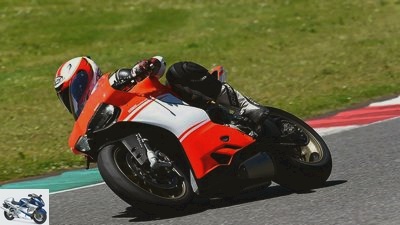
Jahn, Ducati
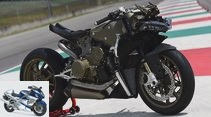
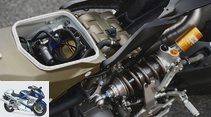
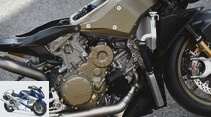
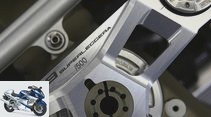
28 photos

Jahn, Ducati
1/28
The Ducati technicians pulled out all the stops. If the listing of the changes in a new model is often a rather boring obligation, in the case of the Superleggera this turns into a pleasure rummaging through a wish list for lightweight construction and tuning freaks.
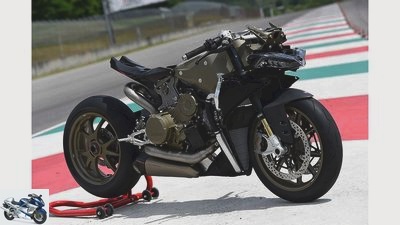
Jahn, Ducati
2/28
For the first time, pistons with only two piston rings are used in a series machine. The piston crowns are milled like on the factory superbikes. Weight saving: 93 grams per piece.
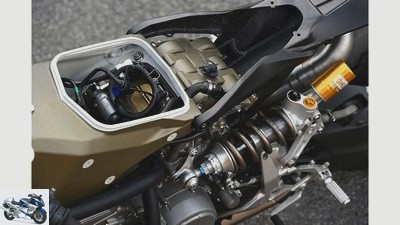
Jahn, Ducati
3/28
The revised electronics ensure that the cockiness of the throttle does not end in expensive scrap.
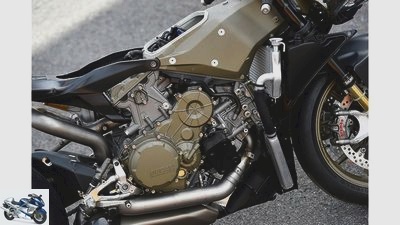
Jahn, Ducati
4/28
The water-cooled two-cylinder four-stroke 90 degree V-engine of the 1199 Superleggera.
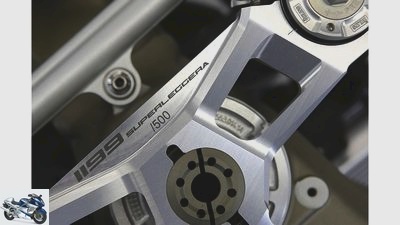
Jahn, Ducati
5/28
500 pieces, and that’s it. For many, the Superleggera must remain a dream. The series is completely sold out.
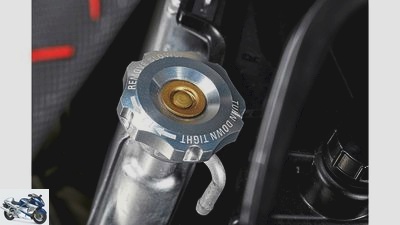
Jahn, Ducati
6/28
It is not so much the nine grams that the radiator cap saves, it rather shows the care that has been devoted to every detail.
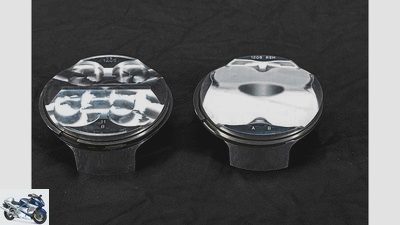
Jahn, Ducati
7/28
On the left a Panigale piston with three rings, the Superleggera only has two.
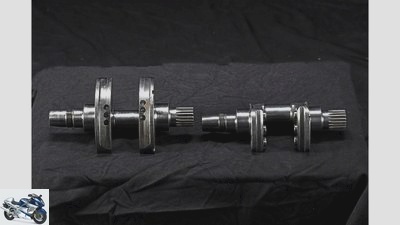
Jahn, Ducati
8/28
Only the crank web stumps are left on the Superleggera (right). Good to see: the three tungsten plugs per cheek.
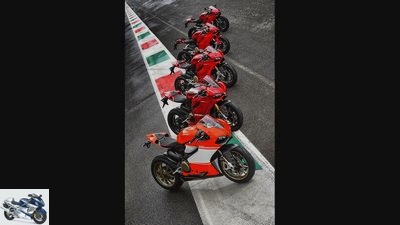
Ducati
9/28
On the other hand, although it is far too good to be chased down the racetrack, it would be a sin not to exploit this potential.
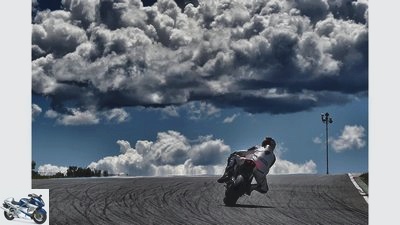
Jahn, Ducati
10/28
In addition to the engine mapping, the traction control has also been adjusted. Even if you turn the accelerator vigorously, your intervention remains discreet, barely noticeable.
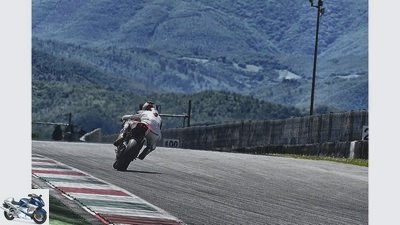
Jahn, Ducati
11/28
Gripping the handlebars too hard when straightening up and accelerating or on the home straight is acknowledged with twitching handlebars and swinging. The only thing that helps is to guide the handlebars very loosely.
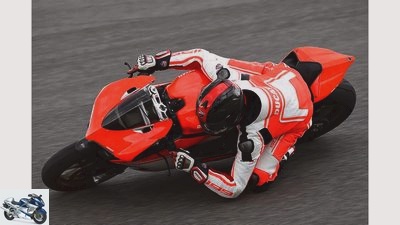
Jahn, Ducati
12/28
Lowering the air pressure on the rear wheel also gave the rear tire more self-damping and thus more calm.
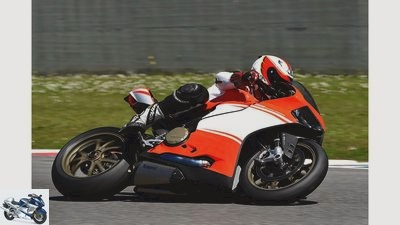
Jahn, Ducati
13/28
This volcano doesn’t give the pilot a moment to breathe.
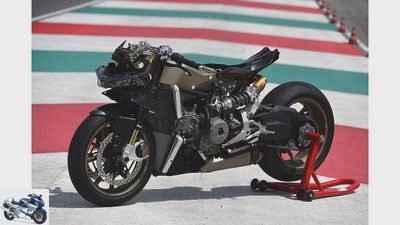
Jahn, Ducati
14/28
Compared to the 1199 Panigale R, the Superleggera saves a total of 12 kg in weight.
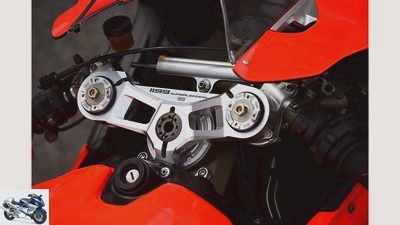
Jahn, Ducati
15/28
The fork was trimmed by Ohlins with multiple changing diameters of the outer tubes for lightweight construction and optimal rigidity.
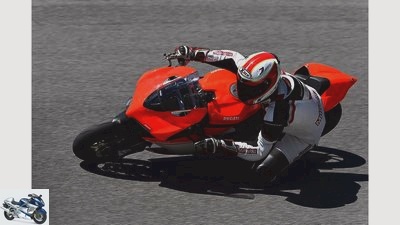
Jahn, Ducati
16/28
"Every five to six years we just have to do something really weird", Ducati press spokesman David James smiles. In 2007 this was the Desmosedici. So now the Superleggera.
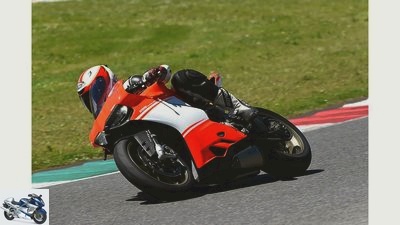
Jahn, Ducati
17/28
One can only say that the operation was successful. As a reminder: If the Panigale already sets standards in terms of lightweight construction, the Superleggera is the logical and consistent continuation of this concept.
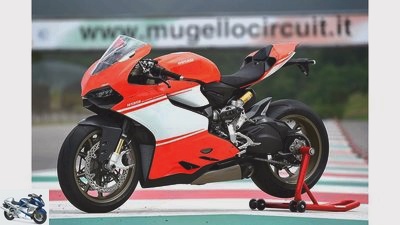
Jahn, Ducati
18/28
Namely, to make whatever components are left as light as possible. Ten kilos less were required, it became twelve.
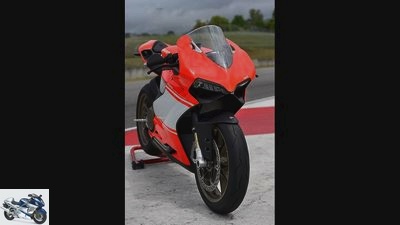
Jahn, Ducati
19/28
The result is a unique and exclusive gem, the key data of which simply take your breath away: only 166 kilograms without fuel stand in the way of the 200 PS of the more powerful V2 – 205 with a race kit.
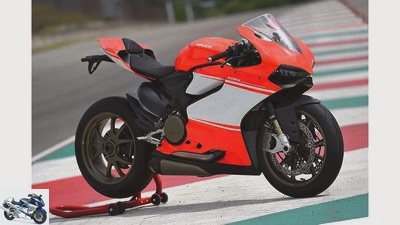
Jahn, Ducati
20/28
This kit is fitted to the bright red Superleggera that is waiting in the pit lane of Mugello to show its pilot what the hammer is.
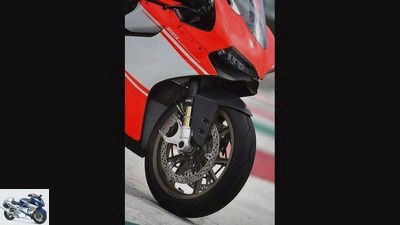
Jahn, Ducati
21/28
It’s worth paying attention to the details and enjoying them before the pit lights turn green.
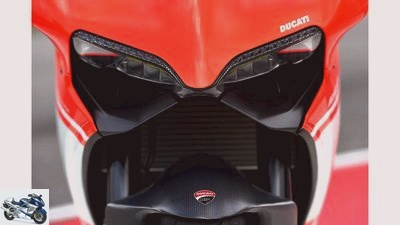
Jahn, Ducati
22/28
It starts with the chassis: it is cast from a magnesium alloy instead of an aluminum alloy.
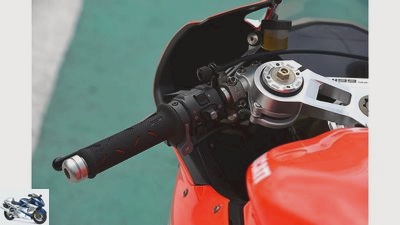
Jahn, Ducati
23/28
The engine brake, wheelie and traction control can now be fine-tuned from the handlebars.
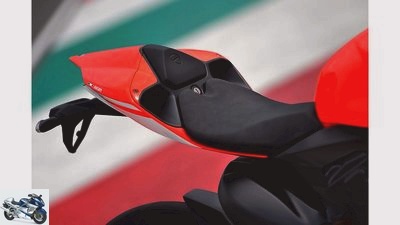
Jahn, Ducati
24/28
The seat pad has become 83 grams lighter.
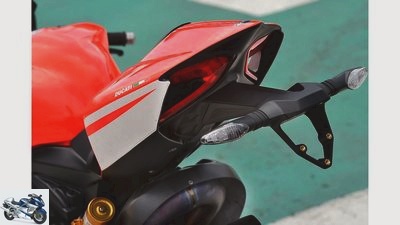
Jahn, Ducati
25/28
Around 200 parts have been changed, explains project manager Eugenio Gherardi. The approximately 100 titanium screws are just one item on this list.
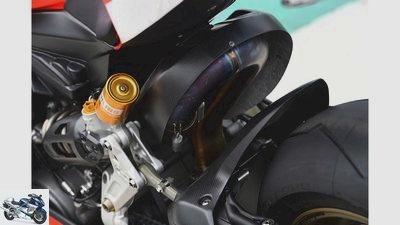
Jahn, Ducati
26/28
The shock absorber has a titanium spring. Everything is street legal.
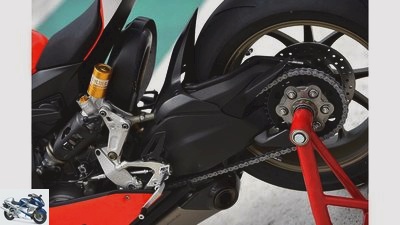
Jahn, Ducati
27/28
The wheels: milled forged magnesium rims from Marchesini.
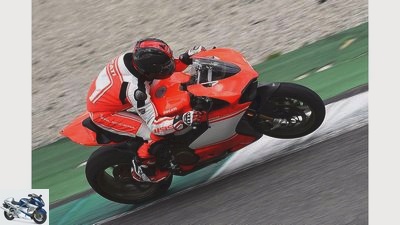
Jahn, Ducati
28/28
At the end of 2013, all Superleggera had already been sold. At a price of 65,000 euros each. Crazy? Perhaps. But a dream. In any case, we can’t wait until the next five or six years are over.
Ducati 1199 Superleggera in the test
Street legal grenade
Developing a racing machine without looking at costs? A dream for every developer. Ducati made it come true. And with the Ducati Superleggera, one of the most fascinating series motorcycles with the best power-to-weight ratio was created. Even if only 500 owners will enjoy this.
“Every five to six years we just have to do something totally crazy,” says Ducati press spokesman David James with a smile. In 2007 this was the Desmosedici. So now the Ducati 1199 Superleggera. One can only say that the operation was successful. As a reminder: If the Ducati Panigale is already setting standards in terms of lightweight construction, the S.uperleggera is the logical and consistent continuation of this concept: namely to make what is still there as light as possible. Ten kilos less were required, it became twelve.
Buy complete article
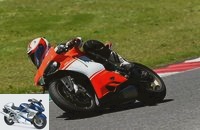
Ducati 1199 Superleggera in the test
Street legal grenade
Ducati 1199 Superleggera, which is waiting in the pit lane of Mugello to show its driver what the hammer is.
Without ABS it would be too light for the SBK World Championship regulations
“If you were to leave out the ABS alone, it would already be too light for the Superbike World Championship regulations – with lights, mirrors and indicators,” winks David James, not without pride. A series machine – even if it is only a small series of 500 pieces – with a better power-to-weight ratio has never existed. The Ducati technicians pulled out all the stops for this. If the listing of the changes in a new model is often a rather boring obligation, in the case of the Ducati 1199 Superleggera this turns into a lustful rummaging through a wish list for lightweight construction and tuning freaks. And so it is worth paying attention to these details and enjoying them before the pit light turns green.
It starts with the chassis: it is cast from a magnesium alloy instead of an aluminum alloy. The wheels: milled forged magnesium rims from Marchesini. The shock absorber has a titanium spring. Everything is street legal. The exhaust: made entirely of titanium. The fork was trimmed by Ohlins with multiple changing diameters of the outer tubes for lightweight construction and optimal rigidity. The outer contour below the lower fork bridge is therefore kept slightly oval. The already light frame rear replaces a self-supporting carbon construction. Consequently, all fairing parts and covers of the Ducati 1199 Superleggera are made of carbon fiber. A light lithium-ion battery is a matter of course. The seat cushion left 83 grams, the milled radiator cap nine.

technology & future
Background Ducati 1199 Superleggera
65,000 euro super sports car sold out
read more
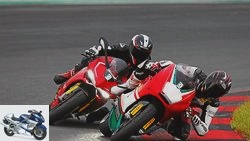
motorcycles
Ducati Desmosedici RR and Ducati 1199 Panigale R in the test
Max Neukirchner and PS test on the racetrack
read more
Modified around 200 parts
Around 200 parts have been changed, explains project manager Eugenio Gherardi. The approximately 100 titanium screws are just one item on this list. The technicians devoted themselves equally intensively to the engine. For the first time, pistons with only two piston rings are used in a series machine. The piston crowns are milled like the factory superbikes. Weight saving: 93 grams per piece. Together with the milled combustion chambers, they raise the compression from 12.5 to 13.2: 1. In addition to the inlet valves, the exhaust valves from Formula 1 supplier Dell West are now also made of titanium. Why the Ducati 1199 Superleggera is allowed to turn 500 rpm higher. The intake cams got a new contour and a little more lift. The technicians really saved the flywheel mass on the crankshaft, of which only a rudimentary remnant is left of the cheeks. Counterweights made of tungsten, which has two and a half times the density of steel, ensure that, despite the 396 grams saving in weight, true running and explosive turning pleasure are maintained.
And then the time has finally come. The pit light shows green. For half an hour, the Mugello GP course belongs exclusively to the tester and the Ducati 1199 Superleggera. The Ducati roars heartily from the mounted racing pots. They save a further 2.5 kilograms and, like a higher windshield, milled covers for the mirror mounts, stands and DDA + data loggers, are part of a race kit that belongs to each of the 500 units built.
Ducati 1199 Superleggera not just pimped Panigale
There are not many corners necessary, then one thing is clear: this is far more than just a pimped Panigale, the Ducati 1199 Superleggera is already damn close to a superbike. It is first and foremost the way in which it digs into the curves that sets it apart from its mass-produced sisters and brings it close to real superbike racers. The Duc turns in as light as a feather, not overly motivated or nervous. But mercilessly direct and with ingenious precision. The higher the speed at the corner entrance, the more concentrated the Superleggera appears. When you close the throttle grip in an inclined position, it does not deviate from the line by a millimeter. It seems to follow the driver’s gaze when choosing the line.
V2 knows neither weakness nor mercy
The fork is not an off-the-rack, but was specially developed for the Ducati 1199 Superleggera, Ducati worked out the setup together with the Ohlins technicians. This is still more on the soft side – at least in that it resembles the series Panigale. The response is fantastic, it literally soaks up uneven floors. The key here, too, is that you throw yourself into the corners with more and more confidence and ever higher speed and find your way into driving maneuvers that you only dare to do when you are very much fused with a motorcycle. Such as the two steep downhill curves Casanova and Savelli, where it is important not to give up any momentum.
Because they are followed by the two fast uphill right-hand curves Arrabiata 1 and 2. The Superleggera twin pulls up the mountain with unbelievable force, pushing forward with brutal force. Freed from the superfluous centrifugal mass, it turns with such vehemence that it makes you dizzy. From 7000 rpm it goes off like a rocket, knows neither weakness nor mercy. This volcano doesn’t give the pilot a moment to breathe, not a second. Not even on the 1.1 kilometer straight. He has top manners, hangs fine and enchanting directly on the gas, runs amazingly quiet thanks to a finely balanced crankshaft. But woe betide him being let off the leash. The automatic gearshift of the Ducati 1199 Superleggera lines up gear after gear thanks to a new gear sensor and revised set-up.
Adapted engine mapping and traction control
The revised electronics ensure that the cockiness of the throttle does not end in expensive scrap. In addition to the engine mapping, the traction control has also been adjusted. Even when you turn the gas vigorously, your intervention remains discreet, barely noticeable. But not only is its tuning new, it now also has an automatic calibration of the tire size. And a wheelie control, adjustable in four stages, which even on the blind hilltop after the fast Arrabiata 2 controls the front wheel of the Ducati 1199 Superleggera very gently and only lets it float slightly above the ground.
All electronic helpers up to and including the engine brake can now be adjusted from the handlebars using a shift paddle. Does everything sound very relaxed? No, because she’s still a little beast. If you grab the handlebars too hard when getting up and accelerating or on the home straight, the Ducati 1199 Superleggera acknowledges with twitching handlebars and swinging. The only thing that helps is to guide the handlebars very loosely. The lowering of the air pressure on the rear wheel also gave the rear tire more self-damping and therefore more calm. Half an hour is over like nothing, the pilot done. Because although incredibly handy and precise, blessed with fabulous electronic driving aids, driving it is an extremely intense affair. Full concentration is required at all times, because everything seems to be happening in fast motion. The Ducati 1199 Superleggera is a street legal grenade.
And although it’s actually too good to be chased down the racetracks, it would be a sin not to exploit this potential. A conflict that only 500 owners will face. Because more copies are not built. When the Ducati 1199 Superleggera was presented to the public for the first time at EICMA 2013, most of them had already been pre-ordered. At the end of 2013 all of them had already been sold. At a price of 65,000 euros each. Crazy? Perhaps. But a dream. In any case, we can’t wait until the next five or six years are over.
Weight savings
Jahn, Ducati
500 pieces, and that’s it. For many, the Superleggera must remain a dream. The series is completely sold out.
Compared to the 1199 Panigale R
- Carbon cladding and other attachments: -1 kg
- Magnesium monocoque, sand-cast: -1 kg
- Carbon rear frame: -1.2 kg
- Titanium exhaust system: -2.5 kg
- Forged magnesium rims: -1 kg
- Lithium-ion battery: -2 kg
- Fork and shock absorber: -1.4 kg
- Superbike pistons: -194 gr
- Crankshaft with counterweights made of tungsten: -396 gr
- SBK chain (520) and sprocket, titanium screws and milled aluminum parts: -1.3 kg
Total weight saving of 12 kg (ready to drive)
Technical data Superleggera
Jahn, Ducati
Compared to the 1199 Panigale R, the Superleggera saves a total of 12 kg in weight.
engine
Water-cooled two-cylinder four-stroke 90-degree V-engine, two overhead, chain-driven camshafts, four valves per cylinder, desmodromic actuation, wet sump lubrication, injection, 2x Ø 68 mm, regulated catalytic converter, 440 W alternator, 12 V / 6 Ah battery , hydraulically operated multi-disc oil bath clutch (anti-hopping), six-speed gearbox, O-ring chain, secondary ratio 41:15.
Bore x stroke: 112.0 x 60.8 mm
Displacement: 1198 cm³
Compression ratio: 13.2: 1
Rated output: 149.0 kW (203 hp) at 11,500 rpm
Max. Torque: 134 Nm at 10,200 rpm
landing gear
Magnesium monocoque, upside-down fork, Ø 43 mm, hydraulic steering damper, adjustable spring base, rebound and compression damping, single-sided swing arm made of aluminum, central spring strut, lying, with lever system, adjustable spring base, rebound and compression damping, double disc brake at the front, Ø 330 mm , Four-piston fixed calipers, rear disc brake, Ø 245 mm, two-piston fixed calipers, traction control, ABS.
Forged magnesium wheels 3.50 x 17; 6.00 x 17
Tires 120/70 ZR 17; 200/55 ZR 17
Dimensions + weight
Wheelbase 1437 mm, steering head angle 65.5 degrees, caster 100 mm, suspension travel f / r 120/130 mm, seat height 830 mm, weight with a full tank of 177 kg, tank capacity 17.0 liters.
Guarantee: two years
Colors: red / white
Price: 65,000 euros
Additional costs: 305 euros
Related articles
-
Driving report Ducati 1199 Superleggera
Ducati 23 pictures Ducati 1/23 Actually, it is unfair to water the reader’s mouth with a motorcycle that he cannot buy. ”So …
-
Ducati Panigale V4 Superleggera: Up to 234 hp and 100,000 euros expensive
Ducati 35 pictures Ducati 1/35 Ducati brings a new V4 top model. leaked 2/35 The Superleggera celebrated its premiere on February 6, 2020. leaked 3/35 …
-
Ducati Panigale Superleggera V4 in the driving report
Ducati. 19 pictures Ducati. 1/19 We had the unique opportunity to try out the new Ducati Panigale Superleggera V4. Ducati. 2/19 Much closer …
-
Hertrampf-Ducati Panigale 1199 R Streetfighter in the test
Jahn 13 photos Jahn 1/13 Denis Hertrampf has already done it again: His TunerGP creation is a piece of cake in terms of the idea and implementation – and…
-
Ducati 1199 Panigale and KTM 1290 Super Duke R in the test
Jahn 41 pictures KTM 1/41 Unlike the Ducati, the Super Duke R suffices with one injection nozzle per cylinder. MRD 2/41 What a difference. Not only at …
-
Ducati 1199 Panigale, EBR 1190 RX and KTM 1190 RC8 R.
Jahn 32 pictures Jahn 1/32 Cloud-free sky, glorious sunshine, the rumble of thunder: Three mighty V2 superbikes race down the slopes of Oschersleben …
-
Comparison test KTM 990 Supermoto versus Ducati Hypermotard 1100
Mayer comparison test KTM 990 Supermoto versus Ducati Hypermotard 1100 Supermoto duel Crass edges or curved lines: With the Hypermotard 1100 …
-
Ducati 1199 Panigale in the 50,000 km endurance test
38 photos 1/38 Summer, sun, milling curves, the Panigale is in its element. Lohse 2/38 “Can I finally drive myself now?” On…
-
Ducati 1299 Superleggera driving report
Ducati 35 pictures Ducati 1/35 Ducati 1299 Superleggera. Ducati 2/35 Ducati 1299 Superleggera. Ducati 3/35 At the zenith of its power, the …
-
Ducati 1299 Superleggera (2017)
Motorcycle fair in Milan EICMA 2019 Presented by Ducati 17 images Ducati 1/17 Ducati 1299 Superleggera. Ducati 2/17 Ducati 1299 Superleggera. Ducati …